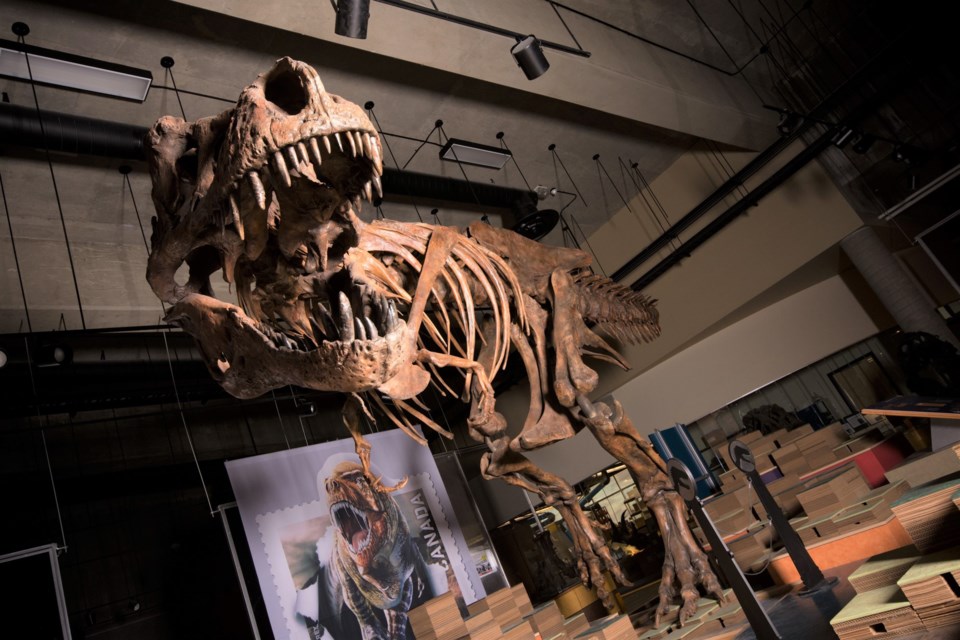The T.rex Discovery Centre has reopened after being closed for a year, giving visitors the chance to see the largest Tyrannosaurus rex specimen and get hands-on in the new Paleo Lab.
Located in Eastend, Sask., in the Cypress Hills region, the discovery centre — home to Scotty, the world’s largest T. rex skeleton — welcomed back visitors on May 22.
Many eager families checked out the Scotty Gallery, heard about the latest discoveries that paleontologists with the Royal Saskatchewan Museum have made, and engaged with the new interactive Paleo Lab Experience by learning about current research, using the two 3-D printers, and digging for fossils.
“We had a huge flow of people through here on the long weekend. Actually surprising, (since) we had a dump of snow down here about six inches and pretty bad weather, so we had no idea what we were going to get,” said Dean Bauche, the new program supervisor, pointing out many people are hungry to visit safe places with their children and have quality experiences.
“I’m delighted … with not only the fact we’re open, but the fact it’s just proved itself to be so manageable,” he continued. “We only have the capacity for 30 people, but we had a steady stream through, and by the time the weekend was through, we had 250 people come through the door.”
The Jurassic period
The great thing about the discovery centre is it’s the epicentre of major fossil finds in Saskatchewan, Bauche said. The nearly complete skeleton of Scotty was found in the area, along with the skeleton of a triceratops. Most of the material in the Paleo Lab that people can see and touch came from a dig site 10 minutes away.
Eastend is also situated in a geographic area containing deposits from the Jurassic era and of pre-historic mammals, all within 40 minutes of each other.
Similar to Drumheller, Alta., and other places in North America, Eastend is rich with fossils. One reason for this, said Bauche, is because Saskatchewan used to be under the Bearpaw Sea. This means visitors shouldn’t be too surprised when they find a shark’s tooth in the hills.
A historical career
Bauche — a consultant, curator, educator and adjudicator, and originally from Eastend — has 22 years of museum experience in Saskatchewan and more years worldwide. In 2019 the Museums Association of Saskatchewan gave him the lifetime achievement award for his efforts as curator and director of galleries for the City of North Battleford.
Bauche explained that his career taught him to respect museums’ role in promoting history and heritage. He noted that the work occurring in Saskatchewan to help people understand the value of the past is “ground-breaking.”
That work helped discover Scotty and laid the infrastructure for the Royal Saskatchewan Museum to exist, be accessible to the public and give kids a better understanding of the province’s history and geology, he continued.
“I’m a huge fan. My background is in museology. Certainly, when I come to a place like this (the discovery centre), to see families in large groups where people are just excited … this is an incredibly levelling field … ,” said Bauche. “This is a unique opportunity, and I just really believe this is exactly what we should be doing to make our lives richer.”
Digging up the past
Bauche has enjoyed watching kids and parents interact with the Paleo Lab, noting it’s one thing to read about paleontology but a different experience getting hands-on looking for fossils. Anything families dig up — the material came from area dig sites — has never been seen before, so it can be a privilege and generate in this field.
“We have a really cool station to work on microfossils (as well),” he continued.
Visitors can use tweezers to find these microfossils — plenty of material has been found recently — while they can also search through a virtual dig site using goggles and equipment.
The Cypress Hills/Eastend area is a “remarkable gem in the rough” in Saskatchewan, while the discovery centre is a unique, world-class venue, said Bauche. Besides the centre, he thought that the Allen Sapp Gallery in North Battleford and the Bill Shurniak Art Gallery in Assiniboia were the two other venues in the province that are as unique.
“There’s nothing more authentic than to have interpretive centres, to have discovery centres, to have museums in the place where the original discoveries (and) the original people lived … ,” he added. “If you’re really looking for something authentic and not Disneyland, then by George, we’re the place.”




